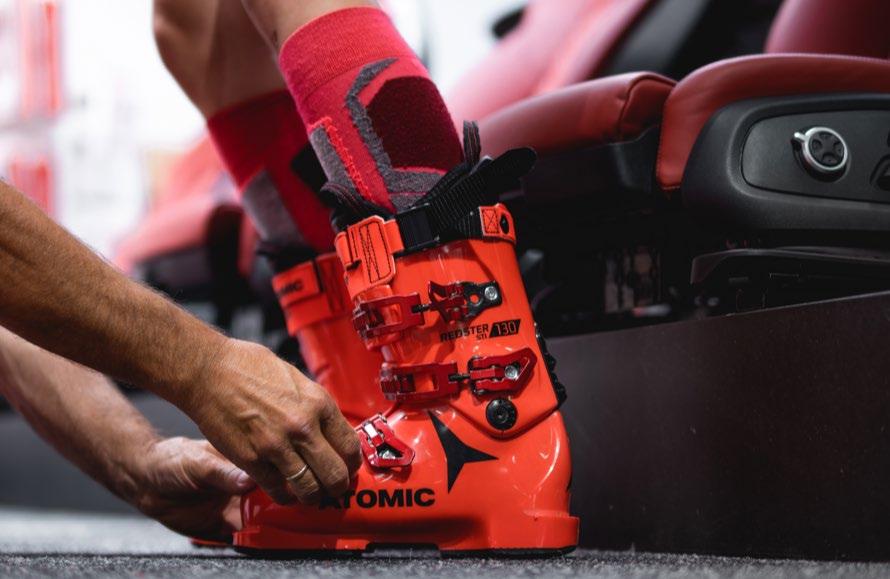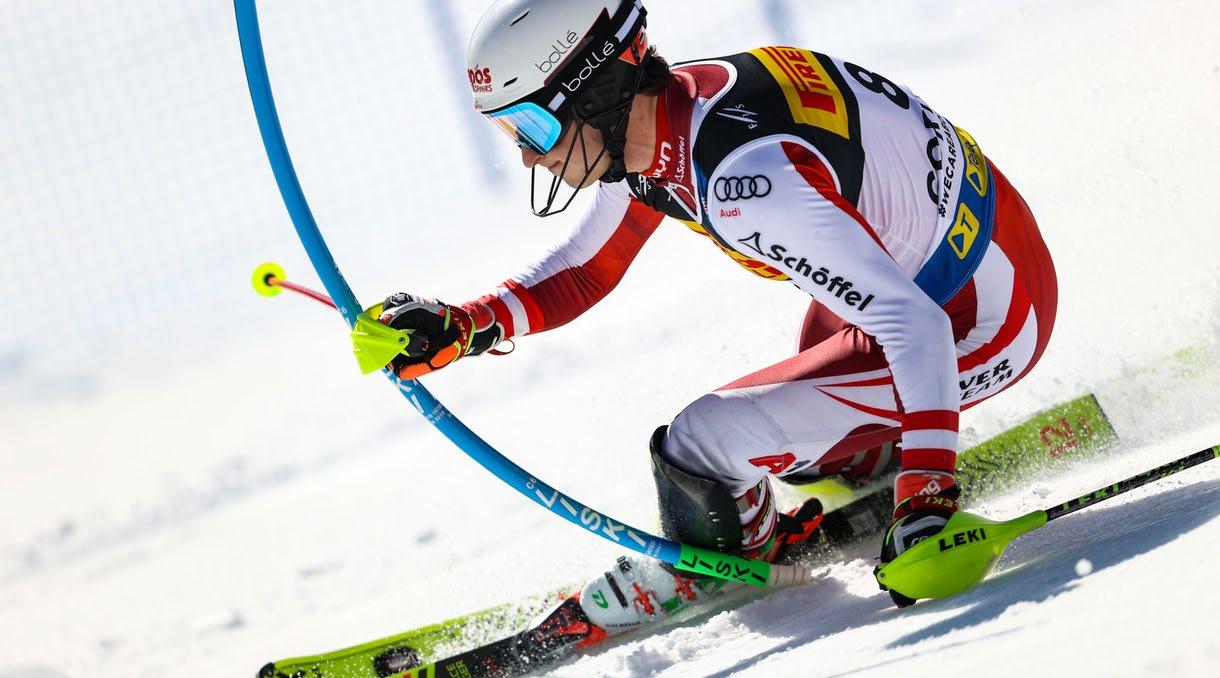
7 minute read
NEWBIE, RUSTY, BAMBOOZLED OR INTRIGUED?
Are you a newbie racer, a rusty (lockdown thwarted) skier, or a parent or teacher bamboozled by what you need for racing and why…?
Has it been a while since you were able to get away skiing on snow? Are you new to the wonderful world of ski racing and need help understanding what you need in the way of equipment?
Advertisement
As a family run ski shop that’s been established since 1965 we have stood the test of time and are always here to help answer your burning questions…
To the newbie racer…
You’re about to encounter an amazing world of fun, friends, new adventures, exhilarating speed, unforgettable experiences and lessons for life. There are lots of pieces of equipment for ski racing, but start simple and add as you go along, we’re here to help and advise you on your journey.
Start with safety – a race helmet and a back protector are the most important items and are now commonplace even for recreational skiing. For racing and training helmets are compulsory and a vast majority of clubs and schools also recommend the use of back protectors.
Helmets – There are two types of race helmets… soft earpiece slalom helmets and hard-earpiece GS helmets.
Soft ear-piece slalom helmets are similar to traditional recreational helmets with comfortable soft ear-pieces and more air vents. The soft-earpiece race versions have a harder more protective outer shell, with the ability to attach a slalom chinguard for protection against slalom poles. Slalom helmets can be used for slalom events on all surfaces, artificial slopes and snow. As they are more ventilated than a full GS helmet they are ideal for UK based summer racing and training.

Hard-earpiece GS helmets have a harder outer shell and withstand a lot more impact. These are therefore safer and also a requirement in the faster disciplines of Giant Slalom, Super-G and Downhill. To conform to GS, SG and DH regulations, hard-earpiece helmets must be FIS approved and have a ‘FIS RH2013’ sticker visible on the back of the helmet.
If you’re planning on training and racing on snow you will usually need a hard-earpiece GS helmet. These can be used for GS or used with a chinguard attached for slalom. If skiing through long slalom gates it is advisable to protect your face with a detachable chinguard. When you buy a race helmet make sure you buy the correct type of helmet for the type of racing you’re doing and that it can have a slalom chinguard fitted to it.
Back protectors are important for racing, dissipating impact and preventing injuries during a fall. These are now better than ever with mouldable foam that shapes to your back, going rigid on impact to dissipate the force, but comfortable and un-inhibiting to wear.
Body Protection – The idea of racing is obviously to go as fast as possible and take the most direct route through a course of red and blue poles. The technique to make this work is to put your body across the poles, tis is where body protection comes in as without it the poles will start to fight back!
To prevent being bruised and battered you need ski pole guards and leg guards. Pole guards are plastic fist protectors that screw on the top of your ski poles and allow you to hit the slalom poles out of your way, leg guards do the same but protect your knees and shins – both of these allow you to ski a straighter and faster route from top to bottom.
Performance – When you start race training your likely to start with rental skis and boots. These will only allow you to get to a certain level in skiing, whether as a racer or a recreational skier. Rental equipment is aimed at beginner to intermediate level skiers to help them easily improve. Once you pass this level in your skiing, progress becomes harder without higher-level equipment. Your next area to invest in will therefore be skis and ski boots… Ski boots are one of the most important parts of skiing. They are the link between you and your skis. A correctly fitting ski boot effects how quickly you’ll progress, your ability to perform and your comfort and enjoyment – all making a huge difference to your skiing. A higher
performing and closer fitting ski boot allows your skis to react faster and more accurately to the movements you’re making with your body.
Make sure the boots are appropriate to your ability level of skiing, your height, your weight and your age. Don’t just use a hand-me-down, a bargain off the internet, or your parents boots – they may not be right, possibly cause injury and ultimately hold you back. Ski boots are one of the most fundamental pieces of equipment you’ll invest in and when you get them right they’ll make a huge difference to your progress and your technique.
To improve the fit even more, custom-moulded footbed insoles are a good addition. These help fill the voids under your arch and cup and hold underneath your foot – this will give you improved control, response and definitely a lot more comfort.
When buying ski boots for children who are still growing, you can often buy them slightly bigger and use a volumereducing shim under the footbed to take up excess space until they grow.
Skis are the next item to invest in. If you’re skiing regularly, your own skis will be the next step to help you progress. Rental skis are aimed at a lower level skier, not giving you the grip, rebound and quick turning ability of a race ski. They are used extensively and are often not maintained anywhere near the level that you would look after your own equipment.

For UK skiing on dry ski slopes and indoor snow domes the skis you buy should be slalom skis. The nature of the shortness of the hills means UK skiing is generally always shorter turning slalom skiing. Slalom skis should be skied approximately between mouth and nose height in length, but is dependent on your height, weight, age and skill level.
For going away racing on snow you may also need a pair of GS skis, a longer turning ski used on longer length GS courses. GS skis are usually skied around head height, but again depends on each person.
Choose the right skis, suited to your ability level, experience, age and physical strength and you’ll notice a massive improvement in the responsiveness of the way they turn.
We’ve supported British skiers on their pathway from beginners to World level skiers in every type of skiing (and snowboarding) and we truly live and breath the sport.
To the rusty racer or skier…
Has it been a while since you last skied? Do your ski boots still fit? Are you’re skis the right length? Do they meet the current regulations for your age group? Does your helmet still fit and is it still appropriate for what type of skiing you’re now doing?
The basics behind how a ski boot should fit – a correctly fitted ski boot should feel similar to a firm handshake. There should be contact all around your foot and leg without any pressure points. Your toes should lightly touch the front of your ski boots when you stand with your knees slightly bent, when you bend your ankle and push forward with your shin into the front of the boot, your toes should pull back away from the front of the boot.
The rules and regulations for ski equipment can change as rapidly as the British weather and can often seem somewhat confusing. Ski length and radius regulations vary depending on the competition and the age group of the racer.
There are currently no ski regulations for UK artificial slope races, however there are length and turn radius regulations for GS skis on snow. An updated version of the latest equipment regulations can be found on www. GBSki.com, the home of all the information you’ll need for race regulations and event schedules.
Whether you want to know what ski is right for you, whether it’s to arrange a specialist ski boot fitting appointment, or maybe you want to learn how to service your own skis, if you have any equipment questions, don’t hesitate to get in touch.

Come and visit the shop and you’ll experience for yourself the largest choice of ski race equipment in the UK (and every other aspect of skiing too). When you visit we will help and advise you and guide you through what might elsewhere be somewhat confusing! Allow some time to visit, as once you become immersed in the Ski Bartlett emporium of skiing you may be with us a while – but don’t worry there is always tea and coffee on tap!
For any help and advice, Ski Bartlett, the ski race experts can be contacted on 020 8848 0040 or www. skibartlett.com. The shop is located on the Uxbridge Road, Hillingdon (West London) and also has a very comprehensive website encompassing every aspect of ski and snowboard equipment.
Delivering our unique family heritage and ski experience from our ski shop in West London, we have been giving help and advice to skiers like you for more than 55 years!










